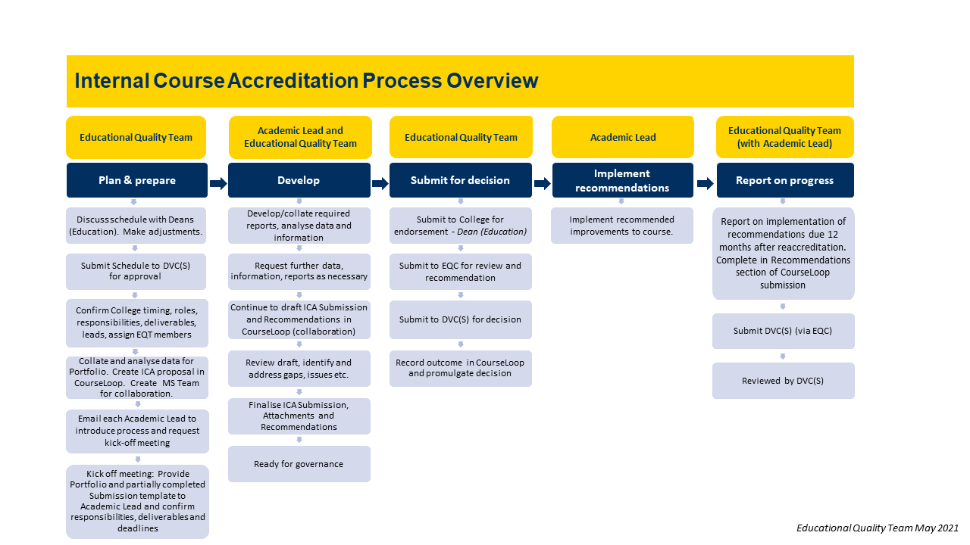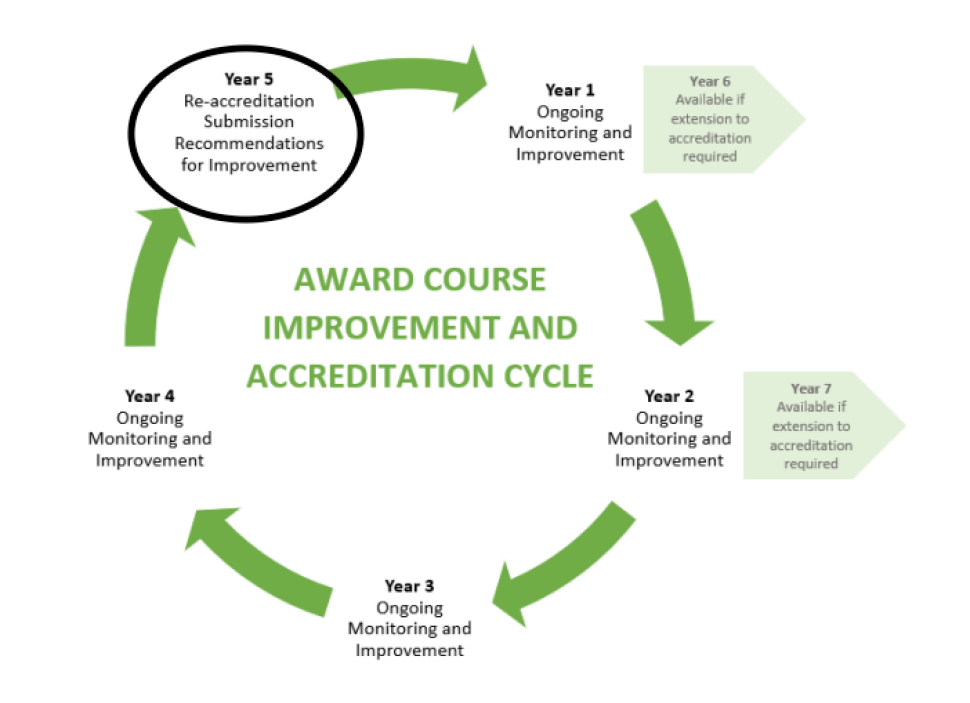Internal course accreditation
Flinders University is a registered higher education provider under the Tertiary Education Quality and Standards Agency Act 2011 and is authorised to self-accredit all course offerings that lead to a higher education qualification.
It is a requirement of this registration that all accredited courses are reviewed every five to seven years to ensure compliance with the Higher Education Standards Framework.
The Internal Course Accreditation process uses evidence and data aligned to the Higher Education Standards Framework to review course performance and develop recommendations to improve the course curriculum and delivery.
Internal course accreditation is fundamental to Flinders University’s Education Quality Framework, supporting the following key areas:
Educational quality assurance – uses robust frameworks, models, policies and processes to ensure educational offerings comply with all legislative and regulatory requirements and reflect excellent practice in core academic structure.
Educational quality improvement – uses a strong central framework and processes to support cycles of continuous improvement, recognising that educational quality is not an end goal, but an ongoing pursuit.
Thus, internal course accreditation ensures legislative compliance, as well as continuous course improvement. The accreditation cycle is part of the broad educational quality process.
Internal course accreditation is governed by the Award Courses Policy and supported by the Award Course Improvement and Accreditation Procedures.
As specified in the procedures, the internal course accreditation submission will:
- align the data and information with the applicable standards of the higher education standards framework, and
- include recommendations created to support the improvement of the course curriculum and delivery, and
- include a plan and timeframes for the implementation of the recommendations. Generally, recommendations must be implemented within twelve months from the date of the approved submission, unless an extension of time has been granted by the Deputy Vice Chancellor (Students).
The Educational Quality Team initiates the review process when courses are due and supports the review submission process. The Education Quality Committee has oversight of internal course accreditations; however, the submission development is led by the relevant teaching program director or their nominee (academic lead). The academic lead is supported by an Educational Quality Team officer who will source and collate a package of course information and complete the non-academic sections of the submission template.
The University’s Accreditation Procedures specify the content that must be in the submission. The format of the submission aligns the content to the applicable standards of the higher education standards framework. To achieve this, the submission consists of two parts:
Portfolio of course information
The portfolio includes all content specified in Section 4.2 of the Procedures and consists of a PDF document and various files required for the ICA submission. The Portfolio and any additional files are developed by the Educational Quality Team and uploaded in CourseLoop and provided to the academic lead at the beginning of the process.
Submission
The submission template is completed by the Academic Lead in CourseLoop, aligning course information, data and recommendations, to the applicable HESF standards. This ensures courses are rigorously assessed against relevant criteria and recommendations are supported by a strong evidence base. It also ensures a consistent, focused approach is applied to internal course accreditations across the University. A URL to the partially completed submission template in CourseLoop (i.e. non-academic contributions to the submission) is provided to the academic lead at the beginning of the process and its completion is a collaborative process between the academic lead, educational quality team and other contributors. Explanatory notes are also provided.
The Portfolio is developed by the Educational Quality Team and provides the Academic Lead (and other contributors) with course information and data to support the development of the CourseLoop submission and recommendations.
The content of the Portfolio includes information to assist the CourseLoop submission, such as previous course review reports, course trends data, third party teaching and credit arrangements, market viability and other quality assurance requirements.
The content required from the Academic Lead (and other contributors) for the CourseLoop submission is based on Section 4.2 Submissions content of the Award Course Improvement and Accreditation Procedures which specifies the data and information that must be included as part of the course accreditation including:
- A summary of the improvements recommended from the last Course Review, and details of how these have been developed and implemented
- Observations and improvements made from the continuous monitoring approach detailed in Section 3 of the Award Course Improvement and Accreditation Procedures including:
- Quality indicator data (KAMs and OPMs) captured, monitored and acted upon since the last submission
- Outcomes based on recommendations made by Course Quality Advisory Groups since the last submission
- Outcomes based on recommendations made by Industry Advisory Boards since the last submission
- Outcomes of any academic calibration activities undertaken since the last submission
- Course Coordinator reports
Any relevant additional content provided by the Academic Lead (and other contributors) as part of the Submission development will be uploaded separately and accessed via the Attachments window in CourseLoop.
The completed submission template (including recommendations and link to the portfolio) is submitted to the relevant Dean (Education) for endorsement on the advice of the College Education Committee and is then submitted to the Educational Quality Committee for review. Based on their advice, the DVC(S) determines whether to reaccredit the course/s for a maximum of seven years (or shorter period) or approve the discontinuation of the course/s.
The Educational Quality Team works with the College to facilitate approval for any course or topic amendments identified in the submission. The Educational Quality Team works with the College to report on the implementation of the recommendations twelve months after the reaccreditation of the course. This report is submitted to the DVC(S) via the submission template in CourseLoop.

"This report by its very length, defends itself against the risk of being read." – Winston Churchill
As the academic lead on an ICA, it is your job to interpret data, evidence claims and address standards while at the same time tell the story of the course/s being reviewed in an engaging and persuasive way. The narrative of your submission is vital to ensure that the required audience – in this case, the Education Quality Committee and DVC(S) – can easily interpret the message and receive the information they need to make their decision.
Be succinct: The committee will be looking for evidence and gaps but won’t have a lot of time at their disposal. Avoid overwhelming them with too much information and verbiage.
Consider your evidence: Think reflectively about what the data represents and interpret it for the committee. Present evidence that is relevant, valid, reliable, and representative of the underlying situation.
Answer the question: What exactly is the section asking for? For instance, if it is about orientation and progression, reflect on how students progress through their studies. Does the data suggest you have high attrition? Why? How do you monitor and support students who might be struggling? Are your practices compliant with the Student Progress Policy? Include in your narrative what orientation information or activities are offered for new students. If you are not aware of any, explain this and note this as an area that requires improvement. This can then become a recommendation. Acknowledging failure to evidence criteria but willingness to improve is better than ignoring or avoiding criteria.
Collaborate on the submission: The ICA process is designed to be collaborative. As the academic lead, you’ll need input from colleagues with different expertise, experiences and viewpoints. Establish who you want to work with on the review and collaborate on the submission as you reflect on the data as a team. Share the task of recommendation responsibility amongst colleagues who are best placed to ensure their deliverability.
Recommendations are a vital element of the ICA submission. Crafting meaningful and achievable recommendations will ensure that improvements made to your course will be data-informed and solution focused. Recommendations should be meaningful, not made for the sake of it. The data in the review should reveal where recommendations are needed.
Example 1: Student evaluation data suggests students are struggling with an overloaded semester and a review of your course design has exposed a poorly scaffolded sequence of topics. Use these findings to inform a recommendation that the teaching team engage in a curriculum structure review with a plan for implementing changes. This is an achievable recommendation with a deliverable that can be measured.
Example 2: A high level review of published course information has revealed discrepancies in information which could mislead students. An important recommendation to arise from this finding could be the correction of published information by College marketing staff within 3 months of the ICA submission.
Example 3: The College has made inter-disciplinary curriculum design a strategic priority, yet your teaching team currently does not collaborate outside its discipline borders. Acknowledge that inter-disciplinary collaboration is not something you currently engage in, and that this is an area for improvement. A sensible and actionable recommendation which could arise from this observation would be setting up a curriculum brainstorm with colleagues from a different discipline to explore potential curriculum synergies and a plan to follow up. This indicates concrete progress towards meeting the College strategic priority.
![]()
Sturt Rd, Bedford Park
South Australia 5042
CRICOS Provider: 00114A TEQSA Provider ID: PRV12097 TEQSA category: Australian University






